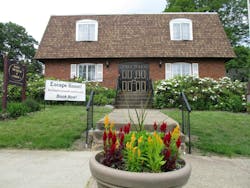Back Page, August 2025
10 Years Ago
Commercial security was our cover focus in August 2015. (ALOA was held in July that year.) “The Evolution of Building Security” tracked the changes from purely mechanical locks to standalone electronic locks to full-featured access control. Tim O’Leary wrote about Altronix’s line of electronic security products for office buildings. Jerry Levine looked at utility locks and other specialty locks for special applications. Schlage NDE wireless locks were highlighted for deeper access control within commercial buildings, securing interior openings. An article on training highlighted Alarm Lock webinars, still a great option. Electronic locks for residential doors were still fairly new in 2015, and we profiled some of the options at that time: the Cal-Royal RS2000, Schlage Touch and Yale Real Living locks. Gale Johnson tested the Kwikset SmartCode 916.
20 Years Ago
Tom Gillespie reviewed the uses for electromagnetic locks. Dick Zunkel advised readers on ways in which older buildings are affected by current ADA laws. Rod Oden suggested commercial door and door closer servicing as a vertical market for locksmiths. Jerry Levine reported on an installation job which included removing a mullion and installing vertical rod exit devices on a double-door opening. Tim O’Leary reviewed Yale 7000 series exit devices. Jerry Levine introduced the Door Control Wizard which is free software provided by Securitron for determining which electronic security products to use. Locksmith Rick Duskiewicz showed his custom installation of mortise locks into doors leading to racquetball courts. Jerry Levine installed a Simplex 900 mechanical pushbutton lock made by Kaba Access Control. Mark Miller assumed leadership of Lockmasters Inc. A feature article showed the various GM ignitions which are equipped with PASSlock technology. High Tech Tools introduced a new vehicle opening manual for medium and heavy trucks. Bill Neff wrote an encompassing article on his new DAP replacement remote heads for Lexus and Toyota. Tiny serviced the locks on a 2005 Buick Terraza. Emily Pike wrote an article on the purchase of Adesco Safe Company by FKI Security Group,
Lock Museum Adventure: Find Pharaoh's Gold
Escape rooms are trending, but the Lock Museum of America offers more than one room. Participants in the Lock Museum Adventure will search for clues in five separate rooms, surrounded by thousands of antique locks, keys, and items related to lock manufacturing. Some of the more unusual artifacts are a 4,000–year old Egyptian lock, a 7,000-pound cannonball safe, and a treasure chest from the Spanish Armada.
The Game: Find Pharaoh's Gold
In 1923, Abigail Atwater, an amateur archaeologist from Terryville, found the long lost tomb of an Egyptian Pharaoh. In her excitement, she broke the strange wooden lock to the chamber and found a casket of enormous treasure.
She returned to her hometown and lived a life of leisure. But as the years went by, her conscience got the better of her. She became a benefactor to the Lock Museum of America. She donated the 4,000-year-old Egyptian wooden lock as a Museum centerpiece. Just before she died, she hid the Pharaoh's gold coins in the museum.
The Lock Museum Adventure takes place in the Lock Museum of America, which houses the largest collection of locks and keys in the United States, located in Terryville, Connecticut, on the site of the former headquarters of the Eagle Lock Company.
Reservations are needed for the Lock Museum Adventure, available through September. For information on the game and visiting this one-of-a-kind museum, visit https://www.lockmuseumofamerica.org/
Minnesota Lawmakers Modify Misguided Ban on Keys
The Minnesota legislature has modified HF 4, the state’s annual budget measure, which originally included a ban on the sale of metal keys that include a small amount of lead. Keys are made primarily of brass, with a small amount of added lead that’s needed to make them durable enough to be cut and stand up to daily use.
The goal was to remove dangerous heavy metals from products that come into contact with children. The trouble is that almost all keys sold today have more lead than the new law's 0.09 percent limit on lead content.
Despite intense opposition from the Minnesota Pollution Control Agency, under the bipartisan agreement in HF 4, keys will be exempt from the current requirements for three years, after which the lead or cadmium content will be limited to 1.5%, matching the California standard for brass used in keys that is widely adopted for many industry products, according to the Security Industry Association.
Keys and locks that are already in use will not be subject to the new limits, and enforcement will be strictly focused on new products once the law takes effect.
